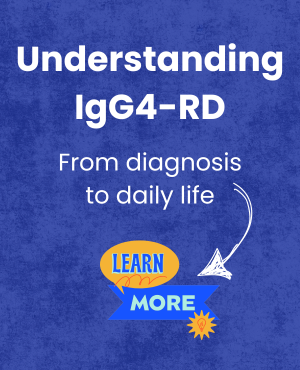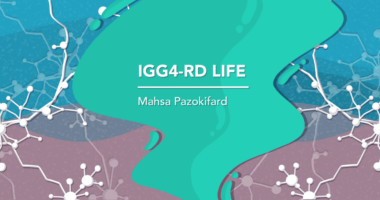IgG4-related disease overview
Last updated May 27, 2025, by Lindsey Shapiro, PhD

Immunoglobulin G4-related disease (IgG4-RD) is a rare disorder where tumor-like masses or painless enlargements can form in virtually any organ, leading to a wide range of possible symptoms. Still, the disease most often manifests in clinical profiles affecting the pancreas, head and neck, or abdomen.
Early diagnosis and treatment are key for preventing organ damage in IgG4-RD, also sometimes called IgG4-related systemic disease or IgG4-related sclerosing disease.
There’s no cure for IgG4-RD, but early and appropriate disease management can help to keep the disease under control, allowing patients a relatively normal life expectancy and good life quality.
What is IgG4-RD?
IgG4-RD is a systemic, or body-wide, immune-mediated disease where immune cells — including T-cells and an activated form of antibody-producing B-cells called plasma cells — densely infiltrate tissues. Plasma cells that secrete IgG4, a type of antibody, are found in particularly high numbers.
This abnormal immune activity leads to inflammation, tissue scarring (fibrosis), and the formation of tumor-like masses and enlargements that can damage organs and impair their function.
One or multiple organs can be affected at any given time, and the disease commonly takes on a relapsing-remitting profile, characterized by periods of worsening disease activity interspersed with periods of clinical stability.
IgG4-RD was recognized as its own distinct condition in the early 2000s. Before that, its various clinical manifestations in different organs were considered individual diseases.
While IgG4-RD is considered a rare disease, its exact prevalence is not firmly established. A 2023 study estimated that, in 2019, IgG4-RD affected 5.3 per every 100,000 people in the U.S. But as awareness of IgG4-RD as a distinct clinical entity grows, researchers will understand more about the exact IgG4-RD prevalence worldwide.
Causes of IgG4-RD
The exact cause of the abnormal immune activity that characterizes IgG4-RD is not fully understood, and ongoing research is focused on better understanding its underlying mechanisms.
Factors that have been proposed as possible IgG4-RD causes include:
- autoimmune reactions
- infectious triggers
- genetic factors.
IgG4-RD can affect anyone, but is most often diagnosed between the ages of 50-70, and in men. Other possible risk factors include:
- tobacco exposure
- environmental exposures, including asbestos, mineral dusts, chemical solvents, and pollution
- other health conditions, such as autoimmune diseases.
IgG4-RD clinical profiles
In most cases, IgG4-RD affects multiple organs, and there are four patterns of organ involvement, or clinical profiles, that tend to be seen most often:
- Pancreato-hepatobiliary disease, which affects the pancreas, bile ducts, and liver. The bile ducts are the tubes that transport the digestive fluid bile from the liver to the intestines.
- Retroperitoneal fibrosis and aortitis, affecting the back of the abdominal cavity where several tissues and organs are located, including the kidneys and the aorta (the body’s largest artery).
- Head and neck-limited disease, where head and neck structures, such as the tear and salivary glands, and tissues around the eyes are mainly affected.
- Classic Mikulicz syndrome with systemic involvement, which affects head and neck structures but also other tissues and organs throughout the body.
These classifications are not definitive — a person can have features of one or more of them that change over time — but they help provide a framework for doctors to understand how a person is impacted. Virtually any other organ can also be involved in IgG4-RD, although less commonly.

IgG4-RD symptoms
IgG4-RD is slow growing, and often doesn’t cause any symptoms until organ function is substantially impacted. When it does cause symptoms, general ones may include swollen lymph nodes (immune structures throughout the body) and unexplained weight loss. Other common IgG4-RD symptoms depend on which specific tissues are affected, and may include:
- jaundice, or yellowing of the skin or whites of the eyes
- abdominal pain
- gastrointestinal problems
- side or back pain
- urinary or kidney issues
- painless swelling in the face or eyelids
- bulging eyes and/or pain when moving the eyes
- mild eye or mouth dryness
- cough or shortness of breath.
Because essentially any organ can be affected, there are a variety of other less common symptoms that could occur, including but not limited to:
- skin problems, like nodules or thickened patches
- mild fatigue
- neurological issues, such as headaches or sensory changes
- thyroid problems.
IgG4-RD diagnosis
Reaching an IgG4-RD diagnosis can be challenging because the signs and symptoms of IgG4-RD overlap substantially with conditions like cancer, autoimmune diseases, or infections.
A series of evaluations are typically used to diagnose IgG4-RD, including:
- a physical exam, to assess for swelling or masses in commonly affected areas
- blood tests, to measure IgG4, inflammatory markers, and indicators of differential diagnoses
- imaging studies, including MRI, CT scans, or ultrasound, to identify affected organs
- a tissue biopsy, to analyze pieces of affected organs under a microscope and look for characteristic disease features, including immune cell infiltration and certain scarring patterns.
Because there’s no universal set of diagnostic criteria, doctors must look at the entirety of findings and use their own clinical judgment to hone in on the diagnosis.
IgG4-RD treatment
Treatment for IgG4-RD aims to induce and maintain disease remission, preventing new disease activity that could drive organ damage.
First-line IgG4-RD treatment involves glucocorticoids, a class of potent anti-inflammatory and immunosuppressive medications. These are usually started at a high dose and tapered down, as long-term use is associated with serious side effects.
Other immunosuppressive therapies may be considered for people with difficult-to-treat disease and those not tolerating glucocorticoids well.
The only treatment specifically approved for IgG4-RD in the U.S. is Uplizna (inebilizumab-cdon), an antibody-based treatment aimed at reducing levels of B-cells and plasma cells. Rituximab, another B-cell-depleting treatment, is not approved specifically for IgG4-RD, but is frequently used off-label.
In certain cases where immediate relief is needed or where medications have failed to control the disease, surgery may be considered to ensure proper organ function.
IgG4-RD life expectancy and prognosis
Living with IgG4-RD can have a substantial impact on quality of life, likely affecting the person’s ability to work and complete daily activities. But with an early diagnosis and appropriate treatment, the condition can be kept well-controlled and serious organ harm delayed or avoided.
With appropriate care, IgG4-RD life expectancy may also be similar to what’s seen in the general population. While some studies have identified a slightly increased mortality risk with IgG4-RD, IgG4-RD prognosis could be influenced by various factors such as treatment delays or the degree of irreversible damage, especially on vital organs.
Ultimately, consistent communication with a healthcare team as soon as any possible signs of IgG4-RD arise will help ensure proper disease management that limits the impact of IgG4-RD on daily life.
IgG4-RD News is strictly a news and information website about the disease. It does not provide medical advice, diagnosis, or treatment. This content is not intended to be a substitute for professional medical advice, diagnosis, or treatment. Always seek the advice of your physician or other qualified health provider with any questions you may have regarding a medical condition. Never disregard professional medical advice or delay in seeking it because of something you have read on this website.
Recent Posts
- A chiropractor’s functional approach provides relief from my spine issues
- Genome study finds new genetic risk factors predicting IgG4-RD
- Rare IgG4-related GI disease often mistaken for stomach tumors
- With IgG4-RD, disease remission is a process toward progress
- Autoimmune conditions seen in 1 in 10 IgG4-RD patients: Study





